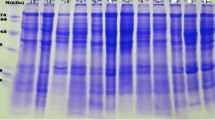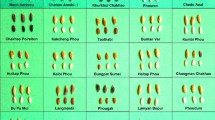Abstract
Cumin (Cuminum cyminum L.), Fennel (Foeniculum vulgare L.) and Longleaf (Falcaria vulgaris Bernh) that all belong to Apiaceae family as medicinal plants are very important in many countries. Study of genetic diversity for medicinal plant is important for researches in future. One of the methods to evaluate plant genetic diversity and classification of them is the electrophoresis of seed storage proteins. This research was conducted in order to evaluate seed protein variability in different Iranian Cumin, Fennel and Longleaf accessions and grouping them based on these proteins as a biochemical marker. For this purpose, the samples were first powdered in liquid nitrogen and seed protein was extracted with extraction buffer. Then total soluble proteins were resolved on 12.5 % sodium dodecyl sulphate polyacrylamide gel electrophoresis gels. The electrophoretic protein pattern showed 38 bands that were low polymorphism among the accessions. The result of cluster analysis showed that the accessions were classified in three groups (all 29 Cumin accessions in the first group, three Fennel ecotypes in second group and three Longleaf accessions in the last one).



Similar content being viewed by others
References
Heywood VH (1971) The biology and chemistry of the Umbelliferae. Academic press, London
Omidbaigi R (2007) Production and processing of medicinal plants. Tarbiat Modares University Press, Tehran
Kafi M (2003) Cumin production and processing. Ferdowsi University of Mashhad Press, Mashhad
Akgul A (1986) Studies on the essential oils from Turkish fennel seeds (Foeniculum vulgare M. var. dulce). Prog Essent Oil Res 4:319–323
Khazaei M, Salehi H (2006) Protective effect of Falcaria vulgaris extract on ethanol induced gastric ulcer in rat. Iran J Pharm Ther 5:43–46
Rahimmalek M, Bahreininejad B, Khorrami M, Sayed Tabatabaaei BE (2009) Genetic variability and geographic differentiation in Thymus daenensis, an endangered medicinal plant, as revealed by inter simple sequence repeat (ISSR). Biochem Genet 47:831–842
Kakaei M, Kahrizi D (2011) Study of seed proteins pattern of Brassica napus varieties via sodium dodecyl sulfate polyacrylamide gel electrophoresis. Int Res J Biotechnol 2:26–28
Ravi M, Geethanjali SF, Sameeyafarheen FM, Maheswaran M (2003) Molecular marker based genetic diversity analysis in rice (Oryza sativa L.) using RAPD and SSR markers. Euphytica 133:243–252
Inam U, Ahmed Khan I, Ahmed H, Ghafoor S, Gul S, Muhammad I, Ilyas M (2010) Seed storage protein profile of rice varieties commonly grown in Pakistan. Asian J Agric Sci 2:120–123
Rostami-Ahmadvandi H, Kahrizi D, Zebarjadi AR, Mostafaie A, Sohrabi-Babahadi F, Kiani S (2011) Study of Peganum harmala genetic diversity based on sodium dodecyl sulphate polyacrylamide gel electrophoresis (SDS-PAGE) analysis. J Agric Sci Technol A 1:1300–1302
Shuaib M, Zeb A, Ali Z, Ali W, Ahmad T, Khan I (2007) Characterization of wheat varieties by seed storage protein electrophoresis. Afr J Biotechnol 6:497–500
Valizadeh M (2001) Seed storage protein profile of grain legumes grown in Iran, using SDS-PAGE. J Agric Sci Technol 3:287–292
Laemmli UK (1970) Cleavage of structural proteins during the assembly of the head of bacteriophage T4. Nature 227:680–685
Bradford MM (1976) A rapid and sensitive method for the quantification of microgram quantities of protein utilizing the principle of protein dye binding. Anal Biochem 72:248–254
Xi J, Wang X, Li S, Zhou X, Yue L, Fan J, Hao D (2006) Polyethylene glycol fractionation improved detection of low abundant proteins by two-dimensional electrophoresis analysis of plant proteome. Phytochemistry 67:2341–2348
Iqbal SH, Ghafoor A, Ayub N (2005) Relationship between SDS-PAGE markers and Ascochyta blight in chickpea. Pak J Bot 37:87–96
Javid A, Ghafoor A, Anwar R (2004) Seed storage protein electrophoresis in groundnut for evaluating genetic diversity. Pak J Bot 36:25–29
Shoorideh H (2004) Evaluation of some indicators of drought resistance in Cumin (Cuminum cyminum L.) and introduce its genotype using storage protein electrophoresis. Dissertation, Shiraz University
Fracaro F, Echeverrigaray S (2006) Genetic variability in Hesperozygis Ringens Benth. (Lamiaceae) an endangered aromatic and medicinal plant of southern Brazil. Biochem Genet 44:479–490
Acknowledgments
The authors would like to gratefully acknowledge all who help us for gathering accessions from different regions.
Author information
Authors and Affiliations
Corresponding author
Rights and permissions
About this article
Cite this article
Masoumi, S.M., Kahrizi, D., Rostami-Ahmadvandi, H. et al. Genetic diversity study of some medicinal plant accessions belong to Apiaceae family based on seed storage proteins patterns. Mol Biol Rep 39, 10361–10365 (2012). https://doi.org/10.1007/s11033-012-1914-3
Received:
Accepted:
Published:
Issue Date:
DOI: https://doi.org/10.1007/s11033-012-1914-3




